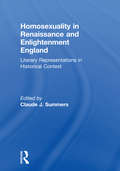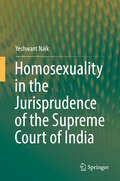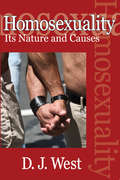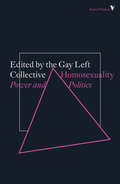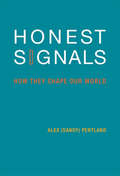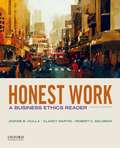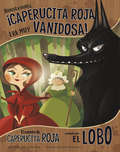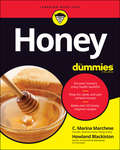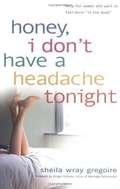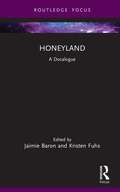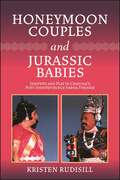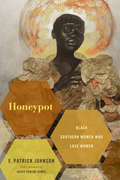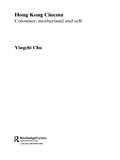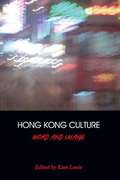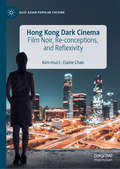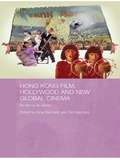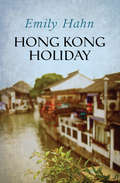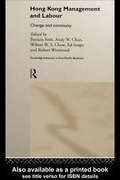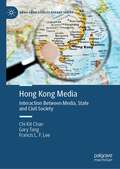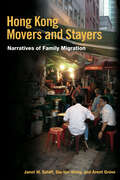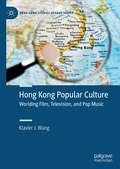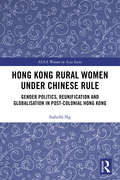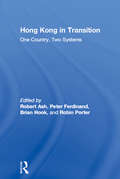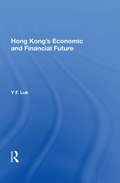- Table View
- List View
Homosexuality in Renaissance and Enlightenment England: Literary Representations in Historical Context
by Claude J SummersThis new book significantly contributes to an increased understanding of the gay and lesbian experience as it illuminates important works of literature and clarifies the status of same-sex desire in English literature from 1500--1760. Homosexual themes can be found throughout the literature of the English Renaissance and Enlightenment, but only rarely are they direct and unambiguous. The essays here are engaged in a vital and necessary process of re-historicizing and re-contextualizing literature. Utilizing a variety of critical methods and proceeding from several different theoretical and ideological presuppositions, these essays raise important questions about the methodology of gay studies, about the conception of same-sex desire, about the depiction of homoerotics, and about the relationship of sexuality and textuality, even as they shed new light on the homosexual import of a number of significant works of literature. Among the authors studied are Christopher Marlowe, William Shakespeare, John Donne, Lady Mary Wroth, Katherine Philips, Aphra Behn, John Cleland, and Thomas Gray. The collection attests both the current intellectual ferment in gay studies and the richness of English Renaissance and eighteenth-century literary representations of homosexuality.Homosexuality in Renaissance and Enlightenment England provides numerous insights into important works of literature and into significant theoretical issues implicit in the process of discerning and defining homosexuality in texts of earlier ages. All the contributors locate their texts in carefully delineated cultural and historical milieux. But they are not unduly constrained by either the tyranny of theory or the anxieties of anachronism. Rather than proceeding from hidebound or fashionably current ideologies, they sift the texts they study for the concrete evidence from which theories of sexuality might be constructed or modified. Hence, the collection will be valuable both for its practical criticism and for its theoretical contributions. It vividly illustrates the variety of gay studies in literature, especially as applied to works of earlier ages.
Homosexuality in the Jurisprudence of the Supreme Court of India
by Yeshwant NaikThe book analyses the Indian Supreme Court’s jurisprudence on homosexuality, its current approach and how its position has evolved in the past ten years. It critically analyses the Court’s landmark judgments and its perception of equality, family, marriage and human rights from an international perspective. With the help of European Court of Human Rights’ judgments and international conventions, it compares the legal and social discrimination meted out to the Indian LGBTI community with that in the international arena. From a social anthropological perspective, it demonstrates how gay masculinity, although marginalized, serves as a challenge to patriarchy and hegemonic masculinity. This unique book addresses the lack of in-depth literature on gay masculinity, elaborately narrating and analysing contemporary gay masculinity and emerging gay lifestyles in India and highlighting the latest research on the subject of homosexuality in general and in particular with respect to India. It also discusses several new issues concerning the gay men in India supported by the living law approach put forth by Eugen Ehrlich.
Homosexuality: Its Nature and Causes
by Donald J. WestThe subject of homosexuality, and especially male homosexuality, has received a great deal of publicity in England and America. The furor began with Kinsey's famous reports on sexual behavior, which brought out the fact that a far higher proportion of the population than was commonly supposed deviated from accepted standards of normality and morality. Taking courage from the apparent safety of large numbers, the sexually unorthodox and their sympathizers began to challenge the criteria of normality, and to question whether sexual habits that were widespread and so deeply entrenched could justifiably be written off as immoral. D.J. West's "Homosexuality" dissects the myths and paranoia surrounding this topic by examining the nature and roots of homosexuality.The politico-legal controversy has tended to overshadow the more fundamental psychological questions concerning the nature and causes of homosexuality. In this field, no striking discoveries have resulted from the increased public interest. Nevertheless, a body of factual data has accumulated, and a number of theories are available. The author's main purpose is to summarize as clearly as possible what is known, to draw what practical conclusions may be possible, and to point out where we are still groping and ignorant.This book deals mainly with male homosexuality because in men the condition causes more clear cut social problems and has been studied more intensely by psychiatrists. Unfortunately, though strongly held opinions abound, hard facts about homosexuality and its possible causes are difficult to obtain. Even now, serious medical and sociological investigations in this subject are scandalously few considering the importance of the questions in human terms. This resistance becomes acutely apparent when a social until a large section of the public is prepared to face the facts squarely and rationally and to support adequate research, our knowledge will remain rudimentary. This book clears away the debris of myth and misunderstanding in a vital area of social concern.
Homosexuality: Power and Politics
by Gay Left CollectiveA socialist journal edited by gay men in the 1970sAfter the leading organizations of radical sexual politics - the Gay Liberation Front and the Gay Marxist Group - imploded or dissolved, the Gay Left Collective formed a research group to make sense of the changing terrain of sexuality and politics writ large. Its goal was to formulate a rigorous Marxist analysis of sexual oppression, while linking together the struggle against homophobia with a wider array of struggles, all under the banner of socialism. This anthology combines the very best of their work, exploring masculinity and workplace organizing, counterculture and disco, the survivals of victorian morality and the onset of the HIV/AIDS crisis.
Honest Signals
by Alex Sandy PentlandHow can you know when someone is bluffing? Paying attention? Genuinely interested? The answer, writes Sandy Pentland in Honest Signals,is that subtle patterns in how we interact with other people reveal our attitudes toward them. These unconscious social signals are not just a back channel or a complement to our conscious language; they form a separate communication network. Biologically based "honest signaling," evolved from ancient primate signaling mechanisms, offers an unmatched window into our intentions, goals, and values. If we understand this ancient channel of communication, Pentland claims, we can accurately predict the outcomes of situations ranging from job interviews to first dates. Pentland, an MIT professor, has used a specially designed digital sensor worn like an ID badge--a "sociometer"--to monitor and analyze the back-and-forth patterns of signaling among groups of people. He and his researchers found that this second channel of communication, revolving not around words but around social relations, profoundly influences major decisions in our lives--even though we are largely unaware of it. Pentland presents the scientific background necessary for understanding this form of communication, applies it to examples of group behavior in real organizations, and shows how by "reading" our social networks we can become more successful at pitching an idea, getting a job, or closing a deal. Using this "network intelligence" theory of social signaling, Pentland describes how we can harness the intelligence of our social network to become better managers, workers, and communicators.
Honest Signals: How They Shape Our World (The\mit Press Ser.)
by Alex PentlandHow understanding the signaling within social networks can change the way we make decisions, work with others, and manage organizations.How can you know when someone is bluffing? Paying attention? Genuinely interested? The answer, writes Alex Pentland in Honest Signals, is that subtle patterns in how we interact with other people reveal our attitudes toward them. These unconscious social signals are not just a back channel or a complement to our conscious language; they form a separate communication network. Biologically based “honest signaling,” evolved from ancient primate signaling mechanisms, offers an unmatched window into our intentions, goals, and values. If we understand this ancient channel of communication, Pentland claims, we can accurately predict the outcomes of situations ranging from job interviews to first dates.Pentland, an MIT professor, has used a specially designed digital sensor worn like an ID badge—a “sociometer”—to monitor and analyze the back-and-forth patterns of signaling among groups of people. He and his researchers found that this second channel of communication, revolving not around words but around social relations, profoundly influences major decisions in our lives—even though we are largely unaware of it. Pentland presents the scientific background necessary for understanding this form of communication, applies it to examples of group behavior in real organizations, and shows how by “reading” our social networks we can become more successful at pitching an idea, getting a job, or closing a deal. Using this “network intelligence” theory of social signaling, Pentland describes how we can harness the intelligence of our social network to become better managers, workers, and communicators.
Honest Work: A Business Ethics Reader
by Clancy Martin Joanne B. Ciulla Robert C. SolomonIn today's business world, ethics is not simply a peripheral concern of executive boards or a set of supposed constraints on free enterprise. Ethics stands at the very core of our working lives and of society as a whole, defining the public image of the business community and the ways in which individual companies and people behave. What people do at work--and how they think about work--determines their attitudes and aspirations, affecting and even structuring their personal lives and habits. <P><P>Working from this premise, Honest Work: A Business Ethics Reader provides a practical overview of business ethics that concentrates on the ethical problems and dilemmas students are most likely to face in their prospective work environments. Classic and recent articles and cases cover a broad spectrum of issues and concerns--from private ethical dilemmas to larger considerations of corporate values--and propose guidelines for thinking about the business world in a moral context. Each reading and case is followed by lively questions for discussion. <P><P>Offering a welcome alternative to the impersonal tone of most business ethics texts, the editors address students in an appealing and conversational manner. They provide engaging chapter introductions that include personal narratives and also present the ideas of great philosophers in a unique way--as emails. <P><P>Ideal for introductory undergraduate and MBA courses in business ethics, Honest Work: A Business Ethics Reader can be read as a coherent narrative but also offers instructors great flexibility, as its various chapters, readings, and cases can be pursued in almost any order. A Companion Website featuring chapter objectives and summaries, study questions, self-tests, and off-site links of interest will soon be available. An Instructor's Manual with Test Bank is available to adopters.
Honestamente, ¡Caperucita Roja era muy vanidosa!: El cuento de Caperucita Roja contado por el lobo (El otro lado del cuento)
by Trisha Speed ShaskanYou think you know the story of "Little Red Riding Hood"? THINK AGAIN! This retelling of the classic story, told from the wolf's perspective, will give you a fresh spin on this famous tale. Was the wolf just really hungry for apples? Was Little Red Riding Hood rotten? This fun fractured tale will leave you with a whole new understanding of the classic story. Fully translated Spanish text. ¿Crees que conoces la verdadera historia de "Caperucita Roja"? ¡ES POSIBLE QUE NO! Esta versión del cuento clásico contada desde la perspectiva del lobo te trae el otro lado de la famosa historia. ¿Será que el lobo solo quería comer manzanas? ¿Será Caperucita Roja una vanidosa? Esta divertida y distorsionada versión te hará ver las cosas de otra manera.
Honey For Dummies
by Howland Blackiston C. Marina MarcheseGet in on the ground level of the next artisan food obsession—honey! Just like wine, cheese, beer or coffee, honey is an artisan food with much to be discovered. Whether you're interested in tasting the various varietals, using it as a cure, or harvesting your own, Honey For Dummies is the guide for you. This book reveals the deep and complex world of honey, its diverse floral sources, and its surprising range of colors, smells, and flavors. You will learn about over 50 single-origin honeys, their sensory profiles, where they are produced and where to buy them. Discover how to taste and evaluate honey using the same methods as professional honey sensory expert. Understand how honey is produced by honeybees, and how beekeepers harvest, and bottle this liquid gold. You'll also discover the historical role honey has played around the world in folklore, religions, and economies. From its health benefits, to recipes, to food pairings, this complete guide covers all things honey! Honey is the latest food trend that can be found at farmers' markets, specialty food shops and on the menu of restaurants. It is produced from bees in every state and just about every country on the planet. Let Honey For Dummies accompany you on your sweet adventure! Discover the rich and complex world of single-origin honey Learn about honey's composition and its myriad health benefits Acquire the skills to taste honey like a pro then how to perfectly pair honeys with all foods Try the book's many wonderful recipes that incorporate honey Honey For Dummies is the perfect companion for every chef, brewer, homesteader, beekeeper or honey lover.
Honey, I Don't Have a Headache Tonight: Help for Women Who Want to Feel More "in the Mood"
by Sheila Wray Gregoire(Foreword by Ginger Kolbaba, editor of Marriage Partnership magazine) From a popular syndicated writer comes this look at changes to a woman's daily life that can help increase her sex drive. Emphasizing the importance of sexual connection between husband and wife in a Christian marriage, Sheila Gregoire examines the reason that sexual desire between partners is often uneven. She recommends changes to behaviors, beliefs, and family life habits that will reduce stress, increase energy, and build connection. From putting a lock on the bedroom door to keep curious children out, to establishing a schedule to keep house-cleaning from being overwhelming, to changing attitudes and healing beliefs about sex, her suggestions are concrete and friendly.
Honeyland: A Docalogue (Docalogue)
by Jaimie BaronThe fourth volume in the Docalogue series, this book explores the significance of the documentary Honeyland (2019) in relation to documentary ethics, the representation of human and animal relations, environmental studies, genre theory, and documentary distribution. The film, focused on a Turkish-speaking woman in Macedonia who cultivates bees to produce honey through an ancient and environmentally sustainable method, raises important questions about the place of humans and economic activity within the broader ecosystem. The documentary also prompts critical reflection about the relationship between observation and storytelling, how the film festival circuit allows certain films to reach a wide audience, the ethics of ethnographic representation, the relationship between human and insect life, and to what extent film can allow us to experience others’ life-worlds. By combining five distinct critical perspectives on a single documentary, this book acts both as an intensive scholarly treatment of the film and as a guide for how to analyze, theorize, and contextualize a documentary text. This book will be of interest to students and scholars of documentary studies, as well as those studying film and media more broadly.
Honeymoon Couples and Jurassic Babies: Identity and Play in Chennai’s Post-Independence Sabha Theater
by Kristen RudisillHoneymoon Couples and Jurassic Babies is the first in-depth study of Sabha Theater, a type of Tamil-language popular theater that started in Chennai (Madras) in the period following India's independence, thriving especially between 1965 and 1985. Breaking new ground in the study of stage and performance, this interdisciplinary book presents a complex view of a significant genre, using historical research and ethnographic information obtained through interviews with performers, writers, and audience members, as well as observations of rehearsals, performances, and television and film shootings. This careful coverage not only contextualizes Sabha Theatre historically, politically, and aesthetically within the wider history of the Tamil stage and a performance scene that includes classical dance and mass media but also reveals how its plays express a Tamil Brahmin identity that is at once traditional and modern. Analyzing what particular plays mean to the specific, urban, elite Brahmin community that produces and consumes them, Kristen Rudisill examines humor that reveals a complex Brahmin identity and surveys markers of moral superiority.
Honeypot: Black Southern Women Who Love Women
by E. Patrick JohnsonE. Patrick Johnson's Honeypot opens with the fictional trickster character Miss B. barging into the home of Dr. EPJ, informing him that he has been chosen to collect and share the stories of her people. With little explanation, she whisks the reluctant Dr. EPJ away to the women-only world of Hymen, where she serves as his tour guide as he bears witness to the real-life stories of queer Black women throughout the American South. The women he meets come from all walks of life and recount their experiences on topics ranging from coming out and falling in love to mother/daughter relationships, religion, and political activism. As Dr. EPJ hears these stories, he must grapple with his privilege as a man and as an academic, and in the process he gains insights into patriarchy, class, sex, gender, and the challenges these women face. Combining oral history with magical realism and poetry, Honeypot is an engaging and moving book that reveals the complexity of identity while offering a creative method for scholarship to represent the lives of other people in a rich and dynamic way.
Hong Kong Cinema: Coloniser, Motherland and Self
by Yingchi ChuExamining Hong Kong cinema from its inception in 1913 to the end of the colonial era, this work explains the key areas of production, market, film products and critical traditions. Hong Kong Cinema considers the different political formations of Hong Kong's culture as seen through the cinema, and deals with the historical, political, economic and cultural relations between Hong Kong cinema and other Chinese film industries on the mainland, as well as in Taiwan and South-East Asia. Discussion covers the concept of 'national cinema' in the context of Hong Kong's status as a quasi-nation with strong links to both the 'motherland' (China) and the 'coloniser' (Britain), and also argues that Hong Kong cinema is a national cinema only in an incomplete and ambiguous sense.
Hong Kong Culture
by Kam LouieHong Kong as a world city draws on a rich variety of foundational "texts" in film, fiction, architecture and other forms of visual culture. The city has been a cultural fault-line for centuries - a translation space where Chinese-ness is interpreted for "Westerners" and Western-ness is translated for Chinese. Though constantly refreshed by its Chinese roots and global influences, this hub of Cantonese culture has flourished along cosmopolitan lines to build a modern, outward-looking character. Successfully managing this perpetual instability helps make Hong Kong a postmodern stepping-stone city, and helps make its citizens such prosperous and durable survivors in the modern world. This volume of essays engages many fields of cultural achievement. Several pieces discuss the tensions of English, closely associated with a colonial past, yet undeniably the key to Hong Kong's future. Hong Kong provides a vital point of contact, where cultures truly meet and a cosmopolitan traveller can feel at home and leave a sturdy mark. Contributors include John Carroll, Carolyn Cartier, David Clarke, Elaine Ho, Douglas Kerr, Michael Ingham, C. J. W.-L. Wee, Chu Yiu-Wai, Gina Marchetti, Esther M.K. Cheung, Pheng Cheah, Chris Berry, and Giorgio Biancorosso.
Hong Kong Dark Cinema: Film Noir, Re-conceptions, and Reflexivity (East Asian Popular Culture)
by Kim-Mui E. ChanThis book is a scholarly investigation of the historical development and contemporary transformation of film noir in today’s Hong Kong. Focusing on the evolvement of cinematic narratives, aesthetics, and techniques, the author balances a deep reading of the multiple filmic plots with a discussion of the cinematic portrayals of gender, romance, identities and power relations. Nuancing the prototypical cinematic form and tragic sense of classical film noir, the recent Hong Kong cinema turns around the classical generic role of film noir at the turn of the century to convey very different messages—joy, hope or love. This book examines how the mainstream cinema, or pre-and-post-Hong Kong cinema in particular, applies a peculiar strategy that makes rooms for the audience to enjoy a pleasure-giving process of reflexivity and also critique the mainstream ideology. With new analytical approaches and angles, this book breaks new ground in offering transcultural and cross-genre analyses on the cinema and its impact in local and international markets. This book is the first major scholarly investigation of the historical development and contemporary transformation of film noir in today’s Hong Kong. Focusing on the evolvement of cinematic narratives, aesthetics, and techniques, the author balances a deep reading of the multiple filmic plots with a refreshing discussion of the cinematic portrayals of gender, romance, identities and power relations. This book also revisits conceptual categories developed by Foucault, Lacan, Derrida and Butler.
Hong Kong Film, Hollywood and New Global Cinema: No Film is An Island (Media, Culture and Social Change in Asia)
by Gina Marchetti Tan See KamIn recent years, with the establishment of the Hong Kong Film Archive and growing scholarly interest in the history of Hong Kong cinema, previously neglected historical documents and difficult-to-access films have offered new research materials. As Hong Kong film history comes into sharper focus, its inextricable links across the decades to Southeast Asia, Korea, Japan, the United States, and to the far reaches of the Chinese diaspora have also become more evident. Hong Kong’s connection with Hollywood involves ties that bring together art cinema and popular genres as well as film festivals and the media marketplace with popular transnational genres. Giving fresh and facsinating insights into the vibrant area of Hong Kong, this exciting new book links Hong Kong with world film culture both within and beyond the commercial Hollywood paradigm. It emphasizes Hong Kong film in relation to other cinema industries, including Hollywood, and demonstrates that Hong Kong film, throughout its history, has challenged, redefined, expanded, and exceeded its borders.
Hong Kong Holiday: China To Me, Hong Kong Holiday, And England To Me
by Emily HahnAuthor of such celebrated and acclaimed works as The Soong Sisters, China to Me, and Fractured Emerald: Ireland, Emily Hahn has been called by the New Yorker &“a forgotten American literary treasure.&” Now Hahn is reintroduced to a new generation of readers, bringing to light her richly textured voice and unique perspective on a world that continues to exist through both history and fiction. In a sense, Hong Kong Holiday is a supplement to Emily Hahn&’s China to Me, marked by the illustrative anecdote and incisive wit that spotlighted the most important incidents of her life during the long months from the Japanese capture of Hong Kong until she was finally returned home on the second voyage of the exchange ship, Gripsholm. Presented here is a crystal-clear picture of the oppressed city—its life in the bazaars, beauty shops, restaurants, and dens. Among the rich and among the poor, in hospitals and in internment camps, Hong Kong Holiday is exotic, intriguing, and all too real.
Hong Kong Management and Labour: Change and Continuity (Routledge Advances in Asia-Pacific Business #No.9)
by Robert Westwood Patricia Fosh Andy W. Chan Wilson W.S. Chow Ed SnapeHong Kong Management and Labour argues, in a series of previously unpublished, completely up-to-date contributions, that economic and social change has been ongoing in Hong Kong for many years, and political change is perhaps less important for labour and management in the region. This book is written bearing in mind the concerns of policy makers and managers - particularly human resource managers, and those interested in labour relations, trade unions, labour markets and law, and comparative management.
Hong Kong Media: Interaction Between Media, State and Civil Society (Hong Kong Studies Reader Series)
by Francis L. Lee Chi Kit Chan Gary TangThis book explores the challenges to news professionalism and media autonomy stemming from the state, market pressure, the digitalization of communication, and a polarized civil society in Hong Kong. China is tightening its control over post-handover Hong Kong, which includes press freedom. Harsh market competition, coupled with shifting readership from mainstream media to digital platforms, is squeezing the business viability of media organizations. The polarization of civil society in post-handover Hong Kong had degraded consensual values upon which news professionalism relies. Journalists have had to reorient news professionalism and media power in the midst of state-society tension, market pressure, and the shifting communication mode driven by digitalization. These are the key questions for Hong Kong media. This dynamic intervention will be of interest to journalists, scholars of civil society, and scholars of Asian politics.
Hong Kong Movers and Stayers: Narratives of Family Migration (Studies of World Migrations)
by Siu-lun Wong Janet W. Salaff Arent GreveHalf a million Hong Kong residents fled their homeland during the thirteen years before Hong Kong's reversion to China in 1997. Nearly half of those returned within the next several years. Filled with detailed, first-hand stories of nine Hong Kong families over nearly two decades, Hong Kong Movers and Stayers is a multifaceted yet intimate look at the forces behind Hong Kong families' successful, and failed, efforts at migration and settlement. Defining migration as a process, not a single act of leaving, Hong Kong Movers and Stayers provides an antidote to ethnocentric and simplistic theories by uncovering migration stories as they relate to social structures and social capital. The authors meld survey analysis, personal biography, and sociology and compare multiple families in order to give voice to the interplay of gender, age, and diverse family roles as motivating factors in migration.
Hong Kong Popular Culture: Worlding Film, Television, and Pop Music (Hong Kong Studies Reader Series)
by Klavier J. WangThis book traces the evolution of the Hong Kong’s popular culture, namely film, television and popular music (also known as Cantopop), which is knotted with the city’s geo-political, economic and social transformations. Under various historical contingencies and due to the city’s special geo-politics, these three major popular cultural forms have experienced various worlding processes and have generated border-crossing impact culturally and socially. The worlding processes are greatly associated the city’s nature as a reception and departure port to Sinophone migrants and populations of multiethnic and multicultural. Reaching beyond the “golden age” (1980s) of Hong Kong popular culture and afar from a film-centric cultural narration, this book, delineating from the dawn of the 20th century and following a chronological order, untangles how the nowadays popular “Hong Kong film”, “Hong Kong TV” and “Cantopop” are derived from early-age Sinophone cultural heritage, re-shaped through cross-cultural hybridization and influenced by multiple political forces. Review of archives, existing literatures and corporation documents are supplemented with policy analysis and in-depth interviews to explore the centennial development of Hong Kong popular culture, which is by no means demise but at the juncture of critical transition.
Hong Kong Rural Women under Chinese Rule: Gender Politics, Reunification and Globalisation in Post-colonial Hong Kong (ASAA Women in Asia Series)
by Isabella NgThis book explores gender dynamics in the indigenous villages (also known as walled villages) in post-handover Hong Kong. It looks at how Hong Kong’s reunification with China has impacted the walled villagers, in particular the women, and how the walled villages’ current gender dynamics in return reflects the changes that have happened in Hong Kong after the reunification with China. It traces the historical development of the walled villages, outlines the nature of walled-village society, and explores the changes currently at work including the erosion of the rural/urban divide, the increasing participation of indigenous women in Hong Kong society more widely and the breakdown of traditional social norms, especially patriarchy.
Hong Kong in Transition: One Country, Two Systems (Routledge Studies in the Modern History of Asia)
by Peter Ferdinand Robin Porter Robert Ash Brian HookHong Kong in Transition offers a perspective on the exceptional constitutional and administrative experiment that has been taking place in Hong Kong, based on a substantial period under Chinese rule. There have been both successes and failures, and a perceptible process of change which is important to document.The particular appeal of this volume lies in the fact that it combines a broad overview with detailed study of individual topics. It is multidisciplinary, and its chapters may be read as 'stand-alone' studies or taken as complementary parts of a whole snapshot of Hong Kong in this critical early period. The chapters are pitched at a level to make them accessible both to undergraduates and to the specialist. Contributors have been drawn from Hong Kong, Macau, the UK, the US, Australia and Germany, reflecting the international interest in the fate of Hong Kong.
Hong Kong's Economic And Financial Future
by Y. F. LukSIGNIFICANT ISSUES SERIES papers are written for and published by the Center for Strategic and International Studies. The series will present the insights of prominent East Asian analysts and draw conclusions about complementarities or divergences that may exist. Those insights, in tum, will serve in the aggregate as the basis for a richer, cross-
